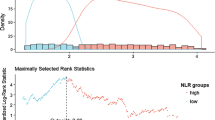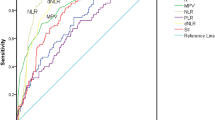Abstract
Purpose
Chronic kidney disease (CKD) is an inflammatory process. In addition to increased morbidity and mortality, inflammation also contributes to the progression of CKD. Neutrophil/lymphocyte ratio (NLR) is a marker of inflammation. Some recent data suggest that NLR may predict the progression of CKD.
Methods
In this study, 5-year data of 740 patients with stage 2–4 CKD were reviewed retrospectively. Demographic data, NLR, CRP, albumin, the amount of proteinuria were recorded. At the beginning and the end of follow-up the glomerular filtration rate (GFR) and the annual GFR decline rate were calculated. Patients were divided to high and low NLR group according to median value of their baseline NLR. Reaching stage 5 CKD or initiation of renal replacement therapy was determined as end-point for follow-up.
Results
The mean age was 62.8 ± 0.57 years, eGFR 40 ml/min/1.73 m2, median NLR was 2.76. NLR increased as the CKD-stage increased. Mean follow-up time was 51.2 ± 30 months and 21.4% of patients reached the end-point. NLR was significantly increased at follow-up (from 3.22 to 5.68, p < 0.001). Annual GFR loss and baseline CRP were higher but baseline albumin and GFR were lower of patients with high NLR. The percent of patients reaching the end-point was not different between the groups with high and low baseline NLR. Kaplan Meier analysis showed that patients with high NLR had significantly lower mean renal survival (86.5 months) than patients with low NLR (105 months) (p < 0.001). In the Cox-regression analysis NLR was not an independent predictor in reaching the end-point but presence of diabetes mellitus, younger age and low baseline eGFR were found effective.
Conclusions
NLR is an indicator of inflammation in chronic kidney disease. It may not be an independent predictor of CKD progression except that the CKD is in a more advanced stage and reflects the associated inflammation. Classical risk factors such as DM and lower GFR are more powerful predictors of progression.


Similar content being viewed by others
References
Silverstein DM (2009) Inflammation in chronic kidney disease: role in the progression of renal and cardiovascular disease. Pediatr Nephrol 24:1445–1452
Yu HT (2003) Progression of chronic renal failure. Arch Intern Med 163:1417–1429
Jacobson HR (1991) Chronic renal failure: pathophysiology. Lancet 338:419–423
Akchurin OM, Kaskel F (2015) Update on inflammation in chronic kidney disease. Blood Purif 39:84–92
Kalantar-Zadeh K (2007) Inflammatory marker mania in chronic kidney disease: pentraxins at the crossroad of universal soldiers of inflammation. Clin J Am Soc Nephrol 2:872
Gungor O, Unal HU, Guclu A, Gezer M, Eyileten T, Guzel FB, Altunoren O, Erken E, Oguz Y, Kocyigit I, Yilmaz MI (2017) IL-33 and ST2 levels in chronic kidney disease: associations with inflammation, vascular abnormalities, cardiovascular events, and survival. PLoS ONE 14(6):e0178939
Xiao WK, Chen D, Li SQ, Fu SJ, Peng BG, Liang LJ (2014) Prognostic significance of neutrophil-lymphocyte ratio in hepatocellular carcinoma: a meta-analysis. BMC Cancer 14:1–10
Wei Y, Jiang YZ, Qian WH (2014) Prognostic role of NLR in urinary cancers: a meta-analysis. PLoS ONE 9:e92079
Azab B, Zaher M, Weiserbs KF, Torbey E, Lacossiere K, Gaddam S, Gobunsuy R, Jadonath S, Baldari D, McCord D, Lafferty J (2010) Usefulness of neutrophil to lymphocyte ratio in predicting short- and long-term mortality after non-ST-elevation myocardial infarction. Am J Cardiol 106:470–476
Chua W, Charles KA, Baracos VE, Clarke SJ (2011) Neutrophil/lymphocyte ratio predicts chemotherapy outcomes in patients with advanced colorectal cancer. Br J Cancer 104:1288–1295
Kidney Disease Improving Global Outcomes (KDIGO) CKD Work Group (2013) KDIGO 2012 clinical practice guideline for the evaluation and management of chronic kidney disease. Kidney Inter Suppl 3:1–150
An X, Mao HP, Wei X et al (2012) Elevated neutrophil to lymphocyte ratio predicts overall and cardiovascular mortality in maintenance peritoneal dialysis patients. Int Urol Nephrol 44:1521–1528
Okyay GU, Inal S, Oneç K, Er RE, Paşaoğlu O, Paşaoğlu H, Derici U, Erten Y (2013) Neutrophil to lymphocyte ratio in evaluation of inflammation in patients with chronic kidney disease. Ren Fail 35:29–36
Turkmen K, Guney I, Yerlikaya FH, Tonbul HZ (2012) The relationship between neutrophil-to-lymphocyte ratio and inflammation in end-stage renal disease patients. Ren Fail 34:155–159
Kocyigit I, Eroglu E, Unal A, Sipahioglu MH, Tokgoz B, Oymak O, Utas C (2013) Role of neutrophil/lymphocyte ratio in prediction of disease progression in patients with stage-4 chronic kidney disease. J Nephrol 26:358–365
Tatar E, Mirili C, Isikyakar T, Yaprak M, Guvercin G, Ozay E, Asci G (2016) The association of neutrophil/lymphocyte ratio and platelet/lymphocyte ratio with clinical outcomes in geriatric patients with stage 3–5 chronic kidney disease. Acta Clin Belg 71:221–226
Kim SM, Kim HW (2014) Relative lymphocyte count as a marker of progression of chronic kidney disease. Int Urol Nephrol 46:1395–1401
Tonyali S, Ceylan C, Yahsi S, Karakan MS (2018) Does neutrophil to lymphocyte ratio demonstrate deterioration in renal function? Ren Fail 40:209–212
Yilmaz G, Sevinc C, Ustundag S, Yavuz YC, Hacıbekiroglu T, Hatipoglu E, Baysal M (2017) The relationship between mean platelet volume and neutrophil/lymphocyte ratio with inflammation and proteinuria in chronic kidney disease. Saudi J Kidney Dis Transpl 28:90–94
Agarwal R, Light RP (2011) Patterns and prognostic value of total and differential leukocyte count in chronic kidney disease. Clin J Am Soc Nephrol 6:1393–1399
Hulstaert F, Hannet I, Deneys V, Munhyeshuli V, Reichert T, De BM, Strauss K (1994) Age-related changes in human blood lymphocyte subpopulations. II. Varying kinetics of percentage and absolute count measurements. Clin Immunol Immunopathol 70:152–158
MacKinney AA Jr (1978) Effect of aging on the peripheral blood lymphocyte count. J Gerontol 33:213–216
Ferrucci L, Guralnik JM, Bandinelli S, Semba RD, Lauretani F, Corsi A, Ruggiero C, Ershler WB, Longo DL (2007) Unexplained anaemia in older persons is characterised by low erythropoietin and low levels of pro-inflammatory markers. Br J Haematol 136:849–855
O’Hare AM, Choi AI, Bertenthal D, Bacchetti P, Garg AX, Kaufman JS, Walter LC, Mehta KM, Steinman MA, Allon M, McClellan WM, Landefeld CS (2007) Age affects outcomes in chronic kidney disease. J Am Soc Nephrol 18:2758–2765
Author information
Authors and Affiliations
Corresponding author
Ethics declarations
Conflict of interest
The authors declare that they have no conflict of interest.
Ethical approval
All procedures performed in studies involving human participants were in accordance with the ethical standards of the institutional and/or national research committee and with the 1964 Helsinki declaration and its later amendments or comparable ethical standards.
Rights and permissions
About this article
Cite this article
Altunoren, O., Akkus, G., Sezal, D.T. et al. Does neutrophyl to lymphocyte ratio really predict chronic kidney disease progression?. Int Urol Nephrol 51, 129–137 (2019). https://doi.org/10.1007/s11255-018-1994-7
Received:
Accepted:
Published:
Issue Date:
DOI: https://doi.org/10.1007/s11255-018-1994-7




